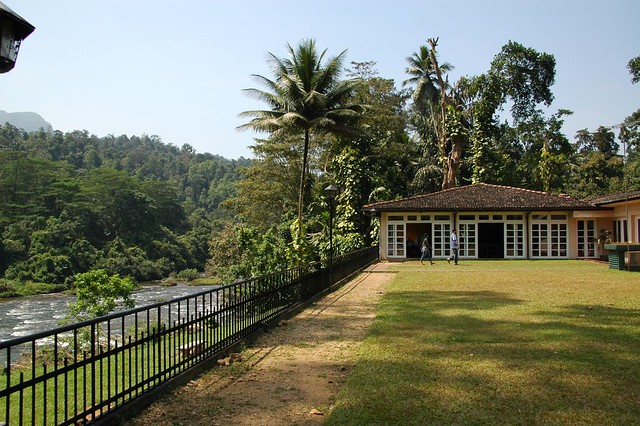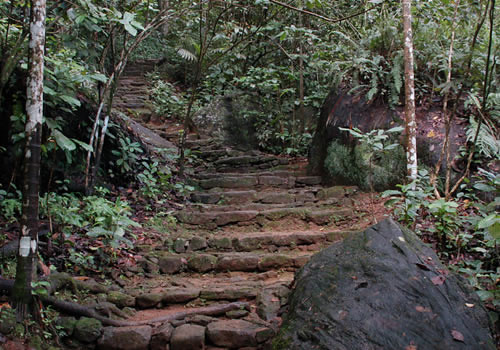Having arrived on time courtesy of Emirates yesterday evening we were met at Colombo International Airport by our guide Diluksha Soysa (Dilu) from the Sri Lanka Bird and Wildlife Team and our driver Heradh and spent the night at the conveniently located Goodwood Plaza Hotel. Our guide suggested meeting at 7am for breakfast but waking early I was out walking the limited grounds of the hotel from dawn at c.6am that produced two new birds being the endemic Red-backed Flameback and Yellow-billed Babbler. We departed soon after breakfast at c.8am for the drive to Kitulgala but soon stopped at an area of paddy-fields that produced an array of common open-country and wetland species and a flock of Indian Swiftlets, a pair of Loten's Sunbirds and more-importantly a pair of the endemic Sri Lanka Crimson-fronted Barbets as they proved to be the only ones that we saw! Whilst traversing some hillsides nearer to Kitagula a flock of hirundines proved to be mainly comprised of Sri Lanka Swallows. We arrived at Kitulgala Rest House at 11.30am and Dilu suggested we commence birding at 2.30pm. Not wanting to waste any time we soon found a fruiting tree in the grounds of the Rest House that was playing host to several confiding Sri Lanka Hanging-Parrots, a Yellow-fronted Barbet, several Yellow-browed Bulbuls, 3 Purple-rumped Sunbirds, and best of all, a smart male Legge's Flowerpecker. We met Paul Bishop for whom the Flowerpecker was also new and he kindly took us to show us another fruiting tree where he'd seen a number of Layard's Parakeets feeding the previous afternoon. Despite a vigil no Parakeets appeared and it was soon time to meet Dilu from where we were paddled across the river and soon walking towards the Kelani River Forest Reserve. Walking through the disturbed forest around the village added a female Black-headed Cuckooshrike and 4 Square-tailed Black Bulbuls. On climbing the hill and reaching the forest proper we were greeted by a wintering Brown-breasted Flycatcher and then a male Sri Lanka Green-Pigeon. Further into the forest alongside some abandoned paddy-fields Dilu went in search of any roosting Owls that he could find while we watched the forest edge seeing 4 Layard's Parakeets, a Sri Lanka Crested Drongo and a pair of the iconic Red-faced Malkohas that worked their way from tree to tree along the far edge of the clearing presumably on their way to roost. Dilu unfortunately failed to find any Owls, and then at dusk, when surrounded by calling Chestnut-backed Owlets we were frustrated by only obtaining a couple of untickable flight views of silhouettes. It then started to pour with rain stopping any further Owling but fortunately our umbrellas kept us relatively dry for the walk back. On arriving at the Rest House I found myself playing host to 5 leeches, although that didn't dampen our spirits, as having seen 18 new species it had proved a far more productive first day than we had envisaged!
Little Cormorant 2
Little Egret 2
Great Egret 2
Intermediate Egret 1
Eastern Cattle Egret 10
Indian Pond-Heron 5
Asian Openbill 4
Black-headed Ibis 6
Brahminy Kite 1
Crested Serpent-Eagle 1
Crested Hawk-Eagle 1
Red-wattled Lapwing 4
Rock Dove c.20
Green Imperial Pigeon 10
Spotted Dove 6
SRI-LANKA GREEN-PIGEON 1 male
SRI LANKA HANGING-PARROT 6
LAYARD'S PARAKEET 4
Alexandrine Parakeet 5
Asian Koel 1
RED-FACED MALKOHA 2
Greater Coucal 2
Brown Hawk-Owl h
CHESTNUT-BACKED OWLET 3+h
INDIAN SWIFTLET 20
White-throated Kingfisher 10
Blue-tailed Bee-eater 8
SRI LANKA CRIMSON-FRONTED BARBET 2
YELLOW-FRONTED BARBET 1
Brown-headed Barbet 1
RED-BACKED FLAMEBACK 1
Barn Swallow 10
SRI LANKA SWALLOW 12
Ashy Woodswallow 1
BLACK-HEADED CUCKOOSHRIKE 1
Red-vented Bulbul 8
SQUARE-TAILED BLACK BULBUL 8
YELLOW-BROWED BULBUL 4
Brown Shrike 1
BROWN-BREASTED FLYCATCHER 1
YELLOW-BILLED BABBLER 4
Plain Prinia 4
Common Tailorbird h
Pale-billed Flowerpecker 1
LEGGE'S FLOWERPECKER 1 male
PURPLE-RUMPED SUNBIRD 3
LOTEN'S SUNBIRD 2
White-rumped Munia 1
Scaly-breasted Munia 2
Black-hooded Oriole 1
White-bellied Drongo 2
SRI LANKA CRESTED DRONGO 1
Common Myna 10
House Crow 100+
Indian Jungle Crow 2
Paddy-fields near Colombo
with poor weather regularly interrupting the recent cricket matches it was a relief to arrive to perfect weather
Water Monitor and Little Egret near Colombo
Non-breeding plumaged Indian Pond-Heron near Colombo
the dark line on the lores eliminates Chinese Pond-Heron
Non-breeding plumaged Intermediate Egret near Colombo
White-bellied Drongo near Colombo
this form leucopygialis restricted to the wet zone of southwest Sri Lanka shows a much darker belly than the nominate form and only has a restricted white vent leading some (but not IOC) to recently elevate it to full species status 'White-vented Drongo'.
Indian Jungle Crows near Colombo

Indian Swiftlet near Colombo
White-bellied Drongo near Colombo
this form leucopygialis restricted to the wet zone of southwest Sri Lanka shows a much darker belly than the nominate form and only has a restricted white vent leading some (but not IOC) to recently elevate it to full species status 'White-vented Drongo'.
Indian Jungle Crows near Colombo

Indian Swiftlet near Colombo
Sri Lanka Crimson-fronted Barbet near Colombo
A fine portrayal of the species by John G. Keulemans appeared in Legge's 'A History of the Birds of Ceylon' Volume 1 published in 1878
Hillsides near Kitagula
Sri Lanka Swallows near Kitagula


the grounds of the Kitagula Rest House
Common Garden Lizard near Kitagula
Green Forest Lizard near Kitagula


Kitagula Rest House
View of the Kelani river from the Kitagula Rest House
Sri Lanka Hanging-Parrot at Kitagula Rest House
Yellow-fronted Barbet at Kitagula Rest House
Brown-headed Barbet at Kitagula Rest House
Male Purple-rumped Sunbird at Kitagula Rest House
Yellow-fronted Barbet at Kitagula Rest House
Brown-headed Barbet at Kitagula Rest House
Male Purple-rumped Sunbird at Kitagula Rest House
Male Legge's Flowerpecker at Kitagula Rest House
Birdlife consider this species Near Threatened as it has a small range within which habitat is continuing to deteriorate in extent and quality. However, the range is not yet severely fragmented or restricted to few locations.
Birdlife consider this species Near Threatened as it has a small range within which habitat is continuing to deteriorate in extent and quality. However, the range is not yet severely fragmented or restricted to few locations.
the species was first described in Ibis No. XIII in January 1874 with an accompanying illustration by John G. Keulemans also featuring Yellow-bellied Flowerpecker
the Kitagula river crossing with ferry at the far side
the 'ferry' across the river
crossing the river
track through the disturbed forest to the Kelani River Forest Reserve
Orchid at Kitagula
Common Garden Lizard at Kitagula


crossing the river
track through the disturbed forest to the Kelani River Forest Reserve
Orchid at Kitagula
Common Garden Lizard at Kitagula

Crested Serpent-Eagle at Kitagula
Female Black-headed Cuckooshrike at Kitagula

Kelani River Forest Reserve
Brown-breasted Flycatcher at the Kelani River Forest Reserve
An east-west migrant that I was keen to see didn't disappoint. Here on its wintering grounds it seemed much commoner in Sri Lanka than in south India.
Male Sri Lanka Green-Pigeon at Kelani River Forest Reserve
Whilst admittedly not its best angle it does show the salient features including its bright yellow forehead, face and throat and its whitish vent that lead to it being treated as a full species in its own right.
Abandoned paddy-fields clearing in the Kelani River Forest Reserve
Brown Shrike at the Kelani River Forest Reserve
This would have proved a challenging identification had we found it on Unst!
Red-faced Malkoha
As my couple of very poor record shots of this species are not worth sharing I will include John G. Keulemans fine portrayal of the species from Legge's 'A History of the Birds of Ceylon' published in 1878-80. The species had proved the highlight of our day and that was before knowing it would prove our only encounter with the species. Birdlife considers this species qualifies as Vulnerable because it has a small, declining population as a result of loss and degradation of its forest habitat.






















































